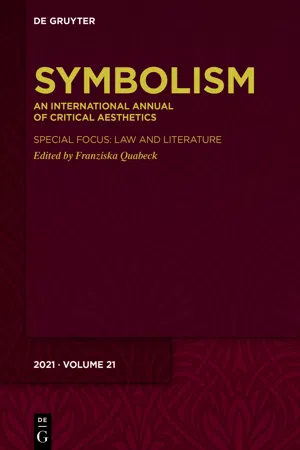
Symbolism 21
An International Annual of Critical Aesthetics
- 303 pages
- English
- ePUB (mobile friendly)
- Available on iOS & Android
Symbolism 21
An International Annual of Critical Aesthetics
About This Book
Special Focus: Law and Literature
This special focus issue of Symbolism takes a look at the theoretical equation of law and literature and its inherent symbolic dimension. The authors all approach the subject from the perspective of literary and book studies, foregrounding literature's potential to act as supplementary to a very wide variety of laws spread over historical, geographical, cultural and spatial grounds. The theoretical ground laid here thus posits both literature and law in the narrow sense. The articles gathered in this special issue analyse Anglophone literatures from the Renaissance to the present day and cover the three major genres, narrative, drama and poetry. The contributions address questions of the law's psychoanalytic subconscious, copyright and censorship, literary negotiations of colonial and post-colonial territorial laws, the European 'refugee debate' and migration narratives, fictional debates on climate change, contemporary feminist drama and classic 19th-century legal narratives. This volume includes two insightful analyses of poetic texts with a special focus on the fact that poetry has often been neglected within the field of law and literature research.
Special Focus editor: Franziska Quabeck, Westfälische Wilhelms-Universität Münster, Germany.
Frequently asked questions
Information
Special Focus: Law and Literature
Introduction: Symbolism, Law and Literature
‘I’ll put a case to you. Mind! I admit nothing.’1 (Charles Dickens, Great Expectations)
If the function of the law is to resolve those conflicts, literature’s paradoxes result from a failure to do so. This failure continues to give literature a supplementary relation to the law, because it draws attention to inequities committed by the law’s exclusions.2
While the dominant canons of literary realism inclined writers and critics toward mainstream rather than extreme situations, and a system of formal and informal censorship restricted the representation of sexual and other passions, the “weird” and disturbing side of human conduct found expression in poetry, sensation novels, and the aesthetic or decadent writing of the 1890s.3
[L]aw is inevitably a matter of language. The law can only be articulated in words. While the order of a court will be imposed on the body or the property of the parties to the case, it will originally have been spoken as a sentence. This is the fundamental connection between law and literature.4
I’ll put a case to you. Mind! I admit nothing. [. . .] Put the case that a woman, under such circumstances as you have mentioned, held her child concealed, and was obliged to communicate the fact to her legal adviser, on his representing to her that he must know, with any eye to the latitude of his defence, how the fact stood about that child. Put the case that at the same time he held a trust to find a child for an eccentric rich lady to adopt and bring up. [. . .] Put the case that he lived in an atmosphere of evil, and that all he saw of children, was, their being generated in great numbers for certain destruction. [. . .] Put the case, Pip, that here was one pretty little child out of the heap, who could be saved, whom the father believed dead, and dared make no stir about; as to whom, over the mother, the legal adviser had this power: ‘I know what you did, and how you did it. [. . .] Give the child into my hands, and I will do my best to bring you off. If you are saved, your child is saved too; if you are lost, your child is still saved.’ Put the case that this was done, and that the woman was cleared. [. . .] Do you comprehend the imaginary case?(GE, 307)
[A]fter a surprisingly gradual shift in the eighteenth century from a system of justice centered on the scaffold to one focused on the trial scene, the period from the 1790s to the 1840s was uniquely dominated by the development of a narrative paradigm oriented to the law courts as a storytelling forum. [. . .] [T]he novel, in becoming the ascendant genre of the nineteenth century, played an active role in a process through which a reinvented criminal trial supplanted the spectacle of the gallows as the culmination of justice.5
Works like these may question the boundaries established by the law, or they may simply reflect such boundaries. In either case, it is the ability of literary texts to represent and draw attention to such boundaries and how they function that produces their greatest insights into law.6
A certain Jarndyce, in an evil hour, made a great fortune, and made a great Will. In the question how the trusts under that Will are to be administered, the fortune left by the Will is squandered away; the legatees under the Will are reduced to such a miserable condition that they would be sufficiently punished if they had committed an enormous crime in having money left them; and the Will itself made a dead letter. All through the deplorable cause, everything that everybody in it, except one man, knows already, is referred to that only one man who don’t know i...
Table of contents
- Title Page
- Copyright
- Contents
- Special Focus: Law and Literature Corresponding editor: Franziska Quabeck
- General Section
- Book Reviews
- Index